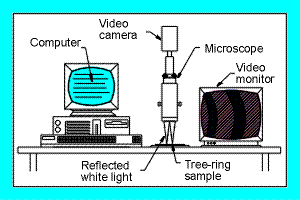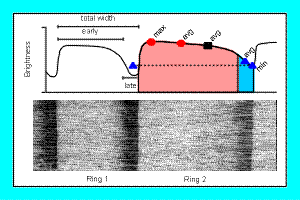 Image-Analysis System: Here are the components, which are all standard
off-the-shelf items, of my reflected-light image analysis system.
The tree-ring sample is an increment core or cross-section as used normally
in dendrochronology. The sample is illuminated with plain white light,
which is reflected diffusely back to the microscope, which focusses the
image to the ccd video camera. Commercial software on the computer
processes the image, which is displayed on a monitor for the user to see
and measure. Other specialized software converts images to data files
typically used by other dendrochronological programs.
Image-Analysis System: Here are the components, which are all standard
off-the-shelf items, of my reflected-light image analysis system.
The tree-ring sample is an increment core or cross-section as used normally
in dendrochronology. The sample is illuminated with plain white light,
which is reflected diffusely back to the microscope, which focusses the
image to the ccd video camera. Commercial software on the computer
processes the image, which is displayed on a monitor for the user to see
and measure. Other specialized software converts images to data files
typically used by other dendrochronological programs. Image
with Brightness Scan: The brightness scan (top) is a composite of all
radial files within each ring (below) without effects of blemishes such
as resin ducts. Ring boundaries and earlywood-latewood boundaries
are determined computationally and verifiable by the system user.
Ring 1 has dark (dense) latewood and a low minimum latewood brightness
value, while Ring 2 has lighter (less dense) latewood and a higher minimum
latewood brightness value. This approach also provides other brightness
variables (marked on scan for Ring 2) and the usual width variables, as
well as odder variables such as area beneath the scan (marked for Ring
2).
Image
with Brightness Scan: The brightness scan (top) is a composite of all
radial files within each ring (below) without effects of blemishes such
as resin ducts. Ring boundaries and earlywood-latewood boundaries
are determined computationally and verifiable by the system user.
Ring 1 has dark (dense) latewood and a low minimum latewood brightness
value, while Ring 2 has lighter (less dense) latewood and a higher minimum
latewood brightness value. This approach also provides other brightness
variables (marked on scan for Ring 2) and the usual width variables, as
well as odder variables such as area beneath the scan (marked for Ring
2).Sheppard, P.R., L.J. Graumlich, and L.E. Conkey. 1996. Reflected-light image analysis of conifer rings for reconstructing climate. The Holocene 6(1):62-68.
| Paul R. Sheppard
Laboratory of Tree-Ring Research The University of Arizona Tucson, AZ 85721 USA |
office: (520) 621-6474
fax: (520) 621-8229
|